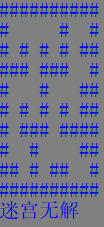#define RIGHT 0
#define DOWN 1
#define LEFT 2
#define UP 3
typedef struct Position{
int x;
int y;
}Position;
Position NextPos(Position now, int dir){
Position next;
int x = now.x;
int y = now.y;
switch(dir){
case RIGHT: next.x = x; next.y = y+1; break;
case DOWN: next.x = x+1; next.y = y; break;
case LEFT: next.x = x; next.y = y-1; break;
case UP: next.x = x-1; next.y = y; break;
}
return next;
}
#include <stdlib.h>
#include <stdio.h>
#include "maze.h"
#define STACK_INIT_SIZE 100
#define STACKINCREMENT 10
#define MAXSIZE 1000
typedef int Status;
typedef struct Ele{
Position pos;
int step;
int dir;
}Ele;
typedef struct{
int Stacksize;
Ele* top;
Ele* base;
}Stack;
Stack* InitStack(void){
Stack* s = (Stack*)malloc(sizeof(Stack));
s->base = (Ele*)malloc(STACK_INIT_SIZE*sizeof(Ele));
if(!s->base){
printf("内存分配失败!\n");
return NULL;
}
else{
s->top = s->base;
s->Stacksize = STACK_INIT_SIZE;
return s;
}
}
int IsStackEmpty(Stack* s){
if(s->top == s->base)
return 1;
else
return 0;
}
int StackLength(Stack* s){
return s->top - s->base;
}
int Push(Stack* s, Ele e){
if(StackLength(s)>=s->Stacksize){
s->base = (Ele*)realloc(s->base,(s->Stacksize + STACKINCREMENT)*sizeof(Ele));
if(!s->base) return 0;
s->top = s->base + s->Stacksize;
s->Stacksize += STACKINCREMENT;
}
*(s->top)++ = e;
return 1;
}
int Pop(Stack* s, Ele* e){
if(IsStackEmpty(s)) return 0;
*e = * --s->top;
return 1;
}
int GetTop(Stack* s, Ele* e){
if(IsStackEmpty(s)){
return 0;
}
*e = *(s->top-1);
return 1;
}
#include <stdio.h>
#include "mazeStack.h"
//输出迷宫地图
void PrintMaze(int maze[10][10]){
int i,j;
for(i=0;i<10;++i){
for(j=0;j<10;++j){
switch(maze[i][j]){
case 0: printf(" "); break; //0表示可走的格子
case -2: printf("#"); break; //-2表示不可走的障碍物
case -1:printf(" "); break; //-1表示探索过的格子
default:printf("*"); break; //1至正无穷表示迷宫解的顺序对应的格子
}
}
printf("\n");
}
}
int main(void){
int exist = 1; //迷宫是否有解.1代表有解,0代表无解。
Stack* path = InitStack();//记录路径
if(path == NULL) exit(-1);
Position now; //当前位置
//初始化位置为入口
now.x = 1;
now.y = 1;
int step=2; //初始步数设为1
int maze[10][10] = {{-2,-2,-2,-2,-2,-2,-2,-2,-2,-2}, //建立迷宫
{-2,0 ,0 ,0 ,0 ,0 ,0 ,0 ,0 ,-2},
{-2,0 ,-2,0 ,-2,0 ,-2,0 ,-2,-2},
{-2,-2,-2,0 ,-2,-2,-2,0 ,0 ,-2},
{-2,0 ,0 ,0 ,-2,0 ,0 ,0 ,-2,-2},
{-2,0 ,-2,0 ,0 ,0 ,-2,0 ,-2,-2},
{-2,0 ,-2,-2,-2,-2,-2,-2,-2,-2},
{-2,0 ,0 ,0 ,0 ,0 ,0 ,0 ,-2,-2},
{-2,-2,0 ,-2,0 ,-2,-2,0 ,0 ,-2},
{-2,-2,-2,-2,-2,-2,-2,-2,-2,-2},};
PrintMaze(maze); //输出迷宫
while(1){
if(maze[now.x][now.y]==0){ //若当前格子可走
maze[now.x][now.y]=step;//走进这个格子
Ele e; //初始化一个e
e.dir = RIGHT; //初始方向向右
e.pos.x = now.x; //e的位置即当前格子
e.pos.y = now.y;
e.step = step; //e记录的步数即为当前步数
Push(path,e); //将e入栈(当前格子加入路径)
if(now.x==8 && now.y==8) break; //若到达终点,则退出循环
now = NextPos(now,e.dir); //试探下一个格子
step++; //步数+1
}
else{ //若当前格子不可走
if(!IsStackEmpty(path)){
Ele e;
Pop(path,&e); //栈顶元素出栈,赋值给e
step--; //步数-1
if(e.dir<UP){ //如果当前方向不为向上(还没有探索完全部方向)
now = NextPos(e.pos,e.dir+1); //试探另一个方向的下一个格子
e.dir++; //顺时针旋转一次
step++; //步数+1
Push(path,e); //将e入栈(当前格子加入路径)
}
while(e.dir==UP){ //如果当前方向为向上(说明已探索完全部方向)
maze[e.pos.x][e.pos.y] = -1; //将格子置-1,表示探索完毕
Pop(path,&e); //栈顶元素出栈,赋值给e
now.x = e.pos.x; //当前位置变更为e的位置
now.y = e.pos.y;
maze[now.x][now.y]=0; //将当前格子设为可探索
step--; //步数-1
}
}
//若起点周围全部探索过说明迷宫无解
if(maze[1][2]<0 && maze[2][1]<0){
printf("迷宫无解");
exist = 0;
break;
}
}
};
printf("\n\n");
if(exist)
PrintMaze(maze);//输出迷宫的解
return 0;
}
运行截图:



